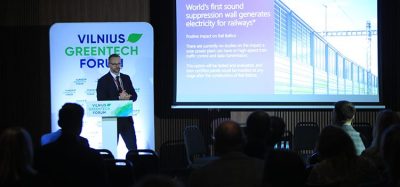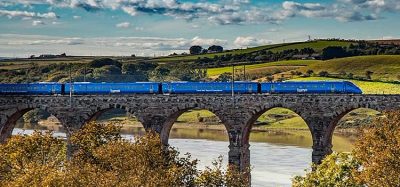UK Rail Minister announces huge funding boost to cut carbon footprint of rail
Posted: 31 January 2019 | Global Railway Review | No comments yet
UK Rail Minister, Andrew Jones, has announced project funding of £1.75 million that looks into solar panels that directly power trains and a system that uses hydrogen and oxygen to produce steam to power engines.


Five projects have been chosen for development funding in the second round of the Department for Transport’s (DfT) First of a Kind (FOAK) competition, which focuses on innovative schemes that can cut the carbon footprint of the UK’s railways – part of the government’s drive to a cleaner, greener economy which is a key part of its modern Industrial Strategy.
The announcement comes as rail industry leaders publish the interim Rail Industry Decarbonisation Taskforce report addressing the challenge set by the DfT in 2018 for cutting emissions and removing diesel-only trains from the network by 2040.
Rail Minister Andrew Jones said: “We want a cleaner, greener rail network and transforming our trains will help make this a reality. The targets we set for 2040 are ambitious but are within our reach. It is encouraging to see the huge efforts already underway to make this happen. This funding will be vital in helping these fantastic projects adapt to the demands of rail and enable their potential roll-out, delivering a cleaner, healthier network for passengers. It also underlines the shared commitment of government and industry to ensuring we have a modern railway that protects our environment.”
Run by Innovate UK and part of the DfT’s wider Accelerating Innovation in Rail (AIR) scheme, the FOAK competition was launched in 2017 and two themes are central to this second round of funding – decarbonising of the railway and improving the passenger experience in stations. The five decarbonisation projects will get £350,000 each to allow them to be adapted for the rail network.
Simon Edmonds, Manufacturing, Materials and Mobility Director at Innovate UK, said: “Travelling or moving goods by train is rightly seen as more sustainable. Yet there is more we can do to make the railway cleaner and greener by decarbonisation. This can be achieved by deploying more energy-efficient systems, using lighter rolling stock and looking at technologies from other industries.”
He continued: “The pioneering projects for which we have announced funding today can reduce both the costs and the carbon footprint of the railway industry and help innovative companies succeed, both here and in export markets.”
The Taskforce report, authored by former Angel Trains CEO Malcolm Brown, concludes that the removal of diesel-only passenger trains can be achieved by 2040, and outlines aims for further investment on a range of alternatives including bi-modes, hydrogen and battery trains.
Among the priority lines for potential battery hybrid trains will be the Lakes Line in Cumbria, and train operator Northern will shortly submit a business plan for it to potentially be one of the first lines to benefit from this innovative technology.
Manufacturer Alstom, engineering company Viva Rail, and rolling stock owners Angel Trains and Porterbrook are also developing a range of alternatively-fuelled trains for the UK network, including battery hybrids and hydrogen powered units.
Malcolm Brown, Chairman of the Rail Industry Decarbonisation Task Force, said: “Our report sets out a credible set of options to meet the challenge to decarbonise. We believe that there is a real opportunity for the rail industry in Great Britain to become a world-leader in developing and delivering low carbon solutions.”
The report also highlights significant opportunities to cut carbon emissions in stations and depots, and underlines levels of support available from research and development funding.
Taskforce Member David Clarke, Technical Director of the Railway Industry Association (RIA) said: “This report is a vital step in achieving the government’s challenge of decarbonising the rail network by 2040. Crucially, the report sets out a selection of potential solutions, including the electrification of intensively used rail routes where appropriate. Now, the industry will set out how it can deliver electrification schemes cost-effectively, which will be explored further in the Railway Industry Association’s Electrification Cost Challenge report – due to be published soon, on 28 February.”
Gary Cooper, Director of Planning, Operations and Engineering at the Rail Delivery Group, which brings together train operators and Network Rail to enable a better railway, said: “With record numbers of people choosing to travel by rail and with annual rail freight haulage equating to eight million HGV journeys, the railway is already cutting up to 7.7 million tonnes of carbon emissions every year with fewer cars and lorries on the road. But we need to do more to keep pace with progress seen in other transport sectors including making better use of existing electrification infrastructure, electrifying more lines where cost-effective and harnessing emerging battery and hydrogen fuel cell technologies.”
RSSB’s Head of Sustainable Development, Anthony Perret, said: “This initial report provides the first steps to a solid evidence base from which the industry can reduce and ultimately eliminate carbon emissions. The whole industry has played its part on this, with extensive consultation on the key recommendations across infrastructure, passenger and freight operators, rolling stock companies, manufacturers and suppliers.”
Related topics
Related organisations
Department for Transport (DfT), Innovate UK, Rail Safety and Standards Board (RSSB), Railway Industry Association (RIA)








